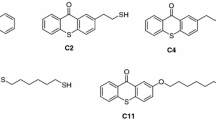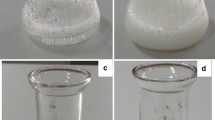Abstract
Highly stable and spherical silver nanoparticles, stabilized by methoxycarbonyl-terminated hyperbranched poly(amine-ester) (HPAE-COOCH3), were synthesized in water with reducing AgNO3/HPAE-COOCH3 using two methods, viz. NaBH4 and ultraviolet irradiation. HPAE-COOCH3 was found to play a key role in the formation of nanoparticles. UV–visible absorption, Transmission electron microscopic (TEM), and Fourier transform infrared spectroscopy (FT-IR) had been used to study the structure and characterization of the silver nanoparticles. The absorption peaks of the silver nanoparticles appear at ~420 nm in UV–visible absorption spectra; average particle size reduced by NaBH4 is ~30 nm, which is ~10 and ~15 nm, respectively, when ultraviolet irradiation time is 12 and 24 h. FT-IR spectra confirm that there is strong interaction between silver nanoparticles and HPAE-COOCH3. And silver nanoparticles/HPAE-COOCH3 aqueous solution can keep stable for more than 3 months.





Similar content being viewed by others
References
Bosman A, Janssen H, Meijer E (1999) About dendrimers: structure, physical properties, and applications. Chem Rev 99:1665–1688
Bradley JS (1994) The chemistry of transition metal colloids. In: Schmid G (ed) Clusters and colloids from theory to applications. VCH, Weinheim (Chapter 6 and references therein)
Crooks RM, Zhao M, Sun L, Chechik V, Yeung LK (2001) Dendrimer-encapsulated metal nanoparticles: synthesis, characterization, and applications to catalysis. Acc Chem Res 34:181–190
Förster S, Antonietti M (1998) Amphiphilic block copolymers in structure-controlled nanomaterial hybrids. Adv Mater 10:195–217
Ghosh K, Maiti SN (1996) Mechanical properties of silver-powder-filled polypropylene composites. J Appl Polym Sci 60:323–331
GrÖhn F, Bauer BJ, Akpalu YA, Jackson CL, Amis EJ (2000) Dendrimer templates for the formation of gold nanoclusters. Macromolecules 33:6042–6050
Li Y, El-Sayed MA (2001) The effect of stabilizers on the catalytic activity and stability of pd colloidal nanoparticles in the suzuki reactions in aqueous solution. J Phys Chem B 105:8938–8943
Lu H, Liu S, Wang X (2003) Silver nanocrystals by hyperbranched polyurethane-assisted photochemical reduction of Ag+. Mater Chem Phys 81:104–107
Mahapatra SS, Karak N (2008) Silver nanoparticle in hyperbranched polyamine: synthesis, characterization and antibacterial activity. Mater Chem Phys 112:1114–1119
Moffit M, Eisenberg A (1995) Size control of nanoparticles in semicondunctor-polymer composites. 1. Control via multiplet aggregation numbers in styrene-based random ionomers. Chem Mater 7:1178–1184
Pérignon N, Mingotaud AF, Marty JD, I Lattes R, Mingotaud C (2004) Formation and stabilization in water of metal nanoparticles by a hyperbranched polymer chemically analogous to PAMAM dendrimers. Chem Mater 16:4856–4858
Plyuto Y, Berquier J, Jacquiod C, Ricolleau C (1999) Ag nanoparticles synthesised in template-structured mesoporous silica films on a glass substrate. Chem Commun 1653–1654
Rogach AL, Shevchenko GP, Afanas ZM, Svidorov VV (1997) Changes in the morphology and optical absorption of colloidal silver reduced with formic acid in the polymer matrix under UV irradiation. J Phys Chem B 101:8129–8132
Schmid G (1992) Large clusters and colloids. Metals in the embryonic state. Chem Rev 92:1709–1727
Sun YY, Liu YQ, Zhao GH, Zhang QJ (2008) Effects of hyperbranched poly(amido-amine)s generation number on synthesis of Ag nanoparticles. J Polym Res 15:269–273
Wan D, Fu Q, Huang J (2006) Synthesis of amphiphilic hyperbranched polyglycerol polymers and their application as template for size control of gold nanoparticles. J Appl Polym Sci 101:509–514
Zhao H, Luo YJ, Yang S, Sun RM (2007) Synthesis and characterization of hyperbranched poly(amine-ester). Chem World 10:629–632
Zhu ZD, Kai L, Wang YC (2006) Synthesis and applications of hyperbranched polyesters—preparation and characterization of crystalline silvernanoparticles. Mater Chem Phys 96:447–453
Acknowledgment
Financial supports from the “Fundamental and Advances Research Program of Education Department of Henan Province” (Project No. 082300420080) is gratefully acknowledged.
Author information
Authors and Affiliations
Corresponding author
Rights and permissions
About this article
Cite this article
Sun, R., Zhao, H., Luo, Y. et al. Methoxycarbonyl-terminated hyperbranched poly(amine-ester) as templates for synthesis of silver nanoparticles. J Nanopart Res 13, 1133–1138 (2011). https://doi.org/10.1007/s11051-010-0105-1
Received:
Accepted:
Published:
Issue Date:
DOI: https://doi.org/10.1007/s11051-010-0105-1




